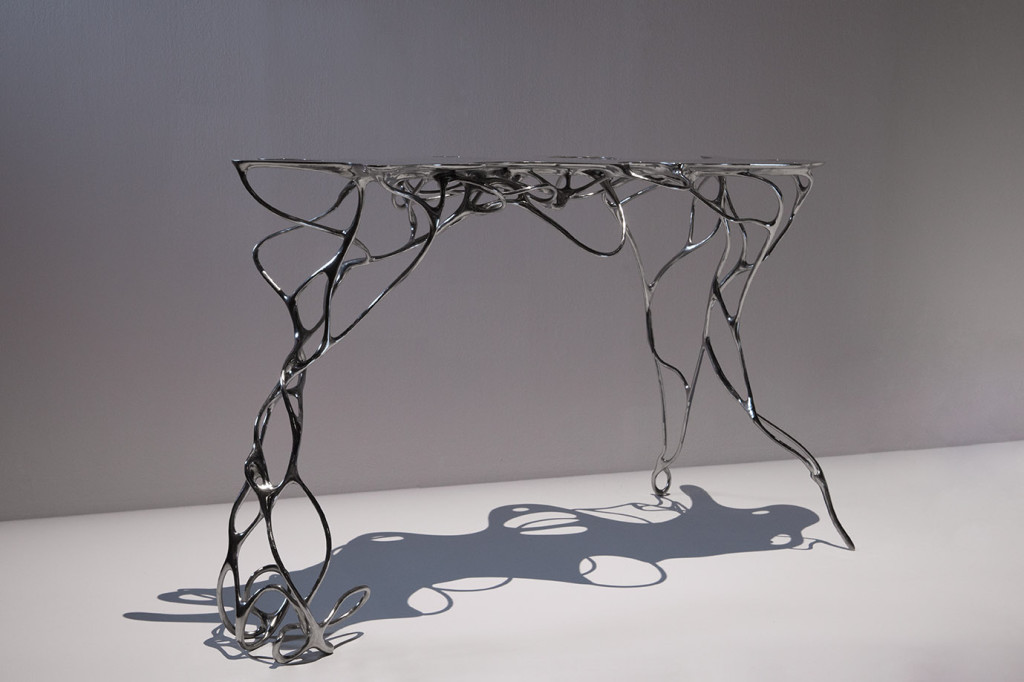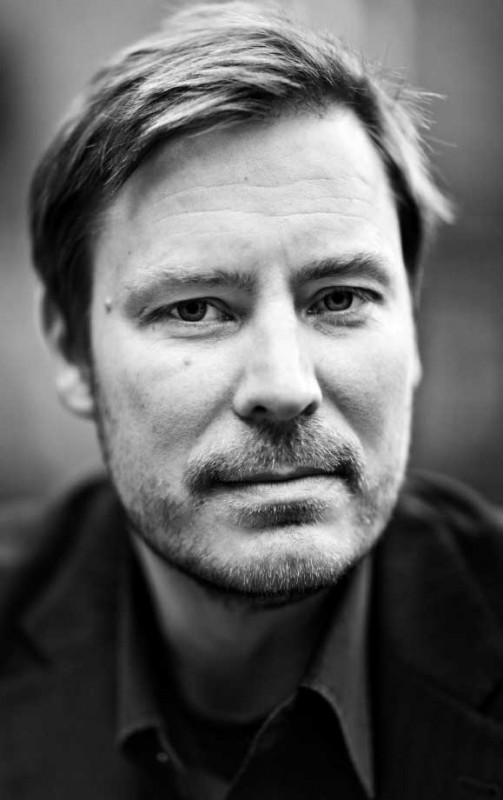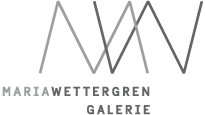
Growth Table Titanium, resulting from a pioneering experimental research initiated in 2013 by Mathias Bengtsson, combines art, craftsmanship and the latest technology in a highly organic form of artistic expression. For the work Growth Table Titanium , Mathias Bengtsson developed a ground-breaking organic growth simulation software based on a parametric grid (approximately 1,000 parameters to set mass, energy, gravity, pressure) within which he allows algorithms to develop. His process interprets the growth model of plants that works on the division and differentiation of cells. The performances of living organisms are analyzed and applied to the performance of materials to generate unique and complex forms that blur the frontiers between design, art, crafts and scientific research. The work is produced using an additive metal manufacturing process known as EBM® (Electron Beam Melting), which is used to produce titanium parts in the aeronautics and defense industries. Mathias Bengtsson is one of the most innovative artists in terms of his use of digital technologies, through which he is able to design objects with complex forms using new materials. His « computational design » is based on a language of algorithms, bringing him close to the approach taken by architects to generate forms using parametric calculations.
Mathias Bengtsson is world famous for his visually striking and technically innovative sculptures. Working with various processes and industrial materials, Bengtsson continues to push back the boundaries of the sculpturally, technically and philosophically possible in terms of three-dimensional design. Always seeking out new means of expression, he disrupts the limits of the established relationships between design, art, crafts and new technologies.
Mathias Bengtsson (born in Copenhagen in 1971) studied at the Royal College of Art and the Danish Design school in Copenhagen. After founding his studio in 2002, he moved to Stockholm in 2007. His creations (Slice Chair – 1998, Spun Chair – 2002, Cellular Chair – 2011, Growth Chair – 2012) combine craftsmanship and cutting-edge technology and push back the sculptural, technical and philosophical boundaries of three-dimensional design.
Museum collections:
Pompidou Centre, Paris France; MoMA, Museum of Modern Art, New York, USA; The Museum of Fine arts, Houston, USA; The Mint Museum of Art, North Carolina, USA; High Museum of Art, Atlanta, USA; Indianapolis Museum of Art, Indianapolis, USA; Montreal Museum of Art, Montreal, Canada; Frank Cohan Collection, Manchester, UK; Manchester Art Gallery, Manchester, UK; The Lowery, Manchester, UK; Cass Sculpture Foundation, West Sussex, UK; Röhsska Museet, Gothenburg, Sweden; Stedelijk Museum, Amsterdam, Holland; Danish Museum of Decorative Arts, Copenhagen, Denmark.

Growth Table Titanium
2016
3D printing (EBM® – Electron Beam Melting)
81 x 66 x 140 cm
Produced by Initials / Groupe Prodways
Collection of the Centre Pompidou, Paris. Musée national d’art moderne – Centre de création industrielle
Purchased with the support of De Gaulle Fleurance & Associés and le Groupe d’Acquisition pour le Design du musée national
Limited edition of 6 unique pieces (+ 4 AP)

Growth Table Titanium
2016
3D printing (EBM® – Electron Beam Melting)
81 x 66 x 140 cm
Produced by Initials / Groupe Prodways
Collection of the Centre Pompidou, Paris. Musée national d’art moderne – Centre de création industrielle
Purchased with the support of De Gaulle Fleurance & Associés and le Groupe d’Acquisition pour le Design du musée national
Limited edition of 6 unique pieces (+ 4 AP)

Growth Table Titanium
2016
3D printing (EBM® – Electron Beam Melting)
81 x 66 x 140 cm
Produced by Initials / Groupe Prodways
Collection of the Centre Pompidou, Paris. Musée national d’art moderne – Centre de création industrielle
Purchased with the support of De Gaulle Fleurance & Associés and le Groupe d’Acquisition pour le Design du musée national
Limited edition of 6 unique pieces (+ 4 AP)

Growth Table Titanium
2016
3D printing (EBM® – Electron Beam Melting)
81 x 66 x 140 cm
Produced by Initials / Groupe Prodways
Collection of the Centre Pompidou, Paris. Musée national d’art moderne – Centre de création industrielle
Purchased with the support of De Gaulle Fleurance & Associés and le Groupe d’Acquisition pour le Design du musée national
Limited edition of 6 unique pieces (+ 4 AP)


Mathias Bengtsson was born in Copenhagen in 1971 and studied furniture design at the Danish College of Design and the Art Centre College in Switzerland before returning to Copenhagen to form the design collective known as “Panic”. Bengtsson went to London in 1996 to study under Ron Arad at the Royal College of Art where he obtained a degree in 1999 before opening with fellow graduates the design studio “At the Third Stroke” and a year later the “Design Laboratory” in partnership with Sam Buxton. In 2002, Bengtsson opened his own studio.
Mathias Bengtsson makes sculptural objects that are both visually striking and technically innovative. Working with diverse industrial materials and processes, he pushes forward the sculptural, technical, and philosophical possibilities of three-dimensional design. Always seeking to take his thinking in new directions, Bengtsson breaks down established boundaries between design, art, craft and technology.
Bengtsson has since the beginning of his artistic career in the 1990s been inspired by natural forms. His early pieces such as the “Slice” and “Spun Chairs” are marvellous examples of organic design, reflecting the heritage from Scandinavian mid-century design masters such as Finn Juhl and Verner Panton. Certain parallels have already been noticed between Juhl, Panton and Bengtsson in their sculptural approach to design, and in 2011 Bengtsson received the acclaimed Finn Juhl Prize of the Wilhelm Hansen Foundation.
However, with the Cellular Chair (2011) in lightweight resin and the Growth Chair (2012) in solid bronze, Bengtsson takes the idea of organic design to another level because as the titles imply, these works are based on the evolution of organic life itself. By means of a computer program, designed by the artist, the structure of the piece is determined uniquely for each piece to simulate the regeneration of bone tissue or vegetal growth, to create a strong, stable construction.
There is something truly ambitious, audacious and crazily inventive in Bengtsson’s efforts to breach the barriers between nature and human artifice. Creating forms that are analogous to Nature (and no longer an imitation) by using Nature’s own secrets and laws of growth is a Promethean enterprise, and his latest works from the Cellular and the Growth series are masterfully illustrating the thinning boundary between the natural and the artificial.
His pieces occupy a room like individual sculptural units, and often they even exceed their functional dimension, albeit without cancelling it. But even though one can still sit in his pieces, comfort is not exactly a priority here. As Bengtsson once said: “The functions of providing optimal comfort and convenience have long been solved – the study of ergonomics was completed in the 1960s,” he argues. “My furniture is about challenging our senses: that is its function.” Indeed, Bengtsson has indeed since the 1990’s, and before the trendy “design art” concept entered the scene, been toning down the boundaries between design, art and craft while focusing on a mutual exchange between these traditionally separated dimensions.
Bengtsson’s artistic impact on the design field has not passed by unnoticed. Curators of art museums on both sides of the Atlantic have been showing his works extensively both in fine art and design contexts such as in the Victoria & Albert Museum, the Design Museum in London and the Rohsska Museum in Göteborg. Moreover his pieces have been boughtfrom an early stage by a number of significant museums such as the MOMA, The Contemporary Arts Museum in Houston; The Manchester Art Galleries, England; Indianapolis museum of art, USA; Carnegie Museum of Art in Pittsburgh, USA, the Milwaukee Art Museum, USA and lately the Centre Pompidou in Paris France.


